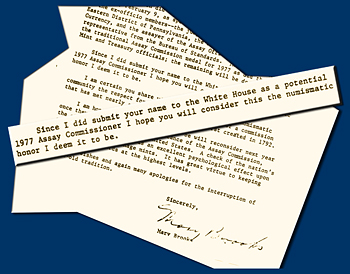|
"Making Cents"
Saturday, April 26, 2008
| I |
The U.S. Assay Commission was established when our first Mint opened in 1792. It followed the common English tradition of having the national coinage examined by a special committee each year in what was known as the "trial of the pyx." It gave confidence to the public that the national coinage was of the correct standard.
Originally, the commission did not consist of any members of the public, and only a few government officials met one day in February to test the standard coinage. It wasn't until the 1830s that Congress approved the addition of members of the public to the annual commission. Such membership assured a more democratic approach to our standards of coinage.
The commission's role was to sample the current coinage for fineness and weight. That usually was conducted and concluded in a single day.
These annual medals were offered each year up to 1977. The medals usually were round and made of silver and were larger than the silver dollar.
From 1901 to 1908, the medals were rectangular and usually bore an image of the current U.S. president on one side and a die maker on the other. Some of the earlier medals also bore presidential images. Since the Mint made no specimens for public sale, these Assay Commission medals have become very collectible and valuable, with some years not known in private collections.
A few issues were made in copper, white metals and pewter (the 1977 issue). A single medal was made in gold. In a book by Julian and Keusch, each annual medal is described along with the known mintage and, in some cases, alternate metals.
The 1977 medal was offered for public sale in a unique oval format featuring Martha Washington on one side. About 1,250 were known to have been sold. It is the least valuable of the medals in the series. When any of the medals show up at public auction, they tend to bring spirited bidding since so few ever come up for public sale.
The more recent issues from the 1960s and early 1970s are virtually unknown in collections except in the hands of the original commissioners. There is no known "complete" private collection, and even major collections are less than three-quarters complete.
The commission met until 1980 when it was officially abolished. No public members attended the final four meetings. There have been bills submitted in recent years to reestablish the commission, since in recent years the Mint has been producing coins of gold and silver — albeit exclusively for collectors and not for general circulation.
Since I came close to an appointment in 1977, I have submitted my name for consideration, should the commission come back from the dead.
Dr. Sol Taylor of Sherman Oaks is president of the Society of Lincoln Cent Collectors and author of The Standard Guide to the Lincoln Cent. Click here for ordering information.
©2008 SCV COMMUNICATIONS GROUP & SOL TAYLOR · ALL RIGHTS RESERVED.

![[Most Recent Quotes from www.kitco.com]](http://www.kitconet.com/images/quotes_special.gif)

